Myelin in the early and late stages of life
11 Nov 2017How could sleep, aging and myelin be related?
Sometimes its good to get out of your wheelhouse.

Two posters presented today explored myelin modifications at different life stages. In the first, the effect of chronic sleep loss during adolescence was found to decrease the thickness of myelin in the Corpus Callosum and the Lateral Olfactory Tract. Adolescence is a key time for myelin development which continues in the human brain until our late 20’s.
This poster made me wonder what I did to my brain during those late nights I spent playing video games during my own adolescence?
What is interesting about this finding on myelin in chronic sleep loss is that previous work showed sleep loss suppressed myelin-related genes. Suggesting at a molecular level an importance for sleep in myelin maintenance. Next steps should better characterize this relationship and how it may relate to adolescent development.

The second poster moved from me the young brain to the aged brain. This poster examined ERK1/2 activation in oligodendrocytes, which had previously been shown to enhance myelination. The role of ERK1/2 has been studied before at a molecular signaling level, so connecting this to cellular and behavioral function can help integrate our understanding of brain function. Further, as we age brain function decreases including affecting memory. Would sustained activation of ERK1/2 in oligodendrocytes affect cognitive decline? From a young age, mice had oligodendrocytes trigger sustained ERK1/2 signalling which persisted as long as the oligodendrocyte lived. Behaviorally this led to an increase in contextual fear memory in aged mice only. However, it remains unclear how to interpret this finding. Perhaps over time some oligodendrocytes die with aging, and it could be that those with sustained ERK1/2 activation survive longer. Therefore in old mice with their persisting ERK1/2 activation oligodendrocytes, these cells could help facilitate this behaviour. This work is preliminary and needs additional experiments to explore this interpretation.
Both these posters introduced me to new concepts on the shared topic of white matter in the brain. I can’t wait to see what new info tomorrow brings!
Patrick E. Steadman, MSc
PhD Candidate, Frankland Lab, The Hospital for Sick Children
MD-PhD Student, University of Toronto
Neuronline: @patrick.steadman
Twitter: @pesteadman
Blog: patricksteadman.ca/blog